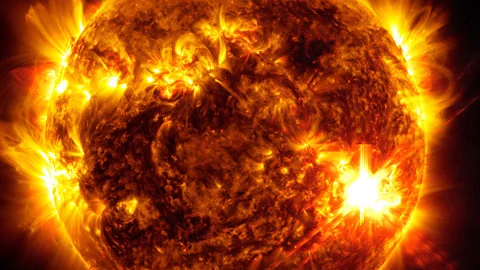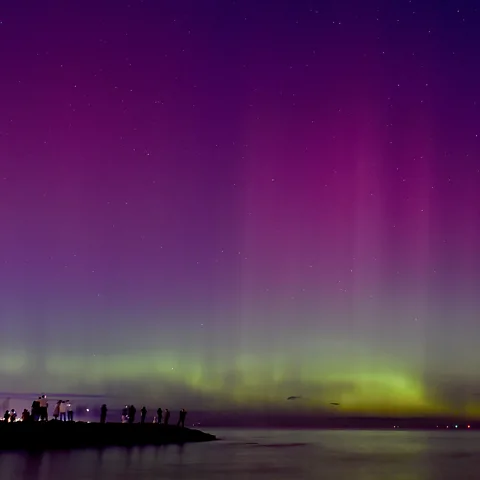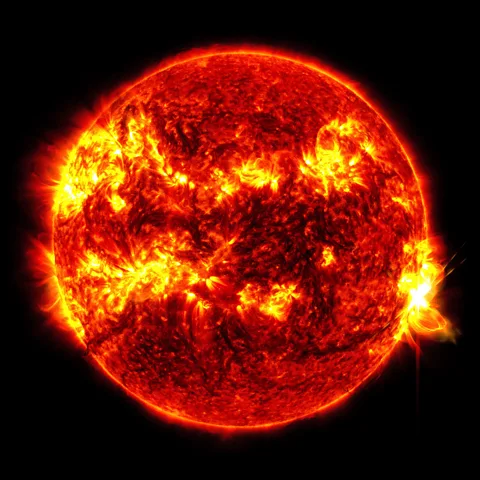from Jonathan O’Callaghan,
 NASA/SDO
NASA/SDOThe Sun is extremely active right now, blasting Earth with the biggest solar storm in 20 years. That’s what it’s doing to the rest of the Solar System.
If you happened to look skyward a few nights in May 2024, there was a good chance you’d see something spectacular. For those at relatively low latitudes, there was a rare chance to see the bright red, pink and green glow of our planet’s aurorae.
A powerful solar storm had sent volleys of charged particles hurtling toward Earth, and as they bounced through our planet’s atmosphere, they set off spectacular displays of the Northern and Southern Lights. The dazzling displays of the aurora borealis were visible much further south than they might normally be – and much further north in the case of the aurora australis thanks to the strength of the geomagnetic storm, the strongest in two decades.
But while this increase in activity from the Sun left many on Earth transfixed by the light show it produced, it has also had a profound effect elsewhere in the Solar System. While most of us wonder about the colors that dance across the night sky, astronomers have looked far beyond to see the strange ways such intense bursts of particles affect other planets and the space between them.
“The sun can shoot material outwards in any direction like a garden sprinkler,” says Jim Wild, a professor of space physics at Lancaster University in the UK. “Effects are felt throughout the Solar System.”
Our Sun is currently heading towards, or has already reached, its solar maximum – the point in an 11-year cycle where it is most active. This means the Sun produces more bursts of radiation and particles from solar flares and events known as coronal mass ejections (CMEs). If these are sprayed in our direction, they can overwhelm the Earth’s magnetic field, causing spectacular auroras, but also creating problems for satellites and power grids.
“Things really seem to be picking up now,” says Mathew Owens, a space physicist at the University of Reading in the UK. “I think we’re about at solar maximum now, so we could see more of these types of storms in the next couple of years.”
 Getty Images
Getty ImagesAround the Sun, many spacecraft are closely observing this increase in activity. One of them, the European Space Agency’s (ESA) Solar Orbiter, has been studying the Sun since 2020 in an orbit that takes it within the path of Mercury. The spacecraft is currently “on the far side of the Sun as seen from Earth,” says Daniel Müller, project scientist for Solar Orbiter Mission in Esa in the Netherlands. “So we see everything that Earth doesn’t.”
The storm that hit Earth in May originates from an active region of solar flares and sunspots, plasma bursts and twisted magnetic fields on the Sun’s surface, known as its photosphere. Solar Orbiter was able to see “some of the flares from this monster active region spinning out of Earth’s view,” says Müller, bright flashes of light and darkened areas called sunspots on the Sun’s surface.
One of Solar Orbiter’s goals is to “connect what’s happening on the Sun with what’s happening in the heliosphere,” says Müller. The heliosphere is a large bubble of plasma that envelops the Sun and the planets of the Solar System as it travels through interstellar space. What Müller and his colleagues hope to learn more about is where the solar wind — the constant stream of particles pouring from the Sun through the Solar System — “blows into the interstellar medium,” he says. “So we’re particularly interested in anything energetic in the Sun that we can find again solar wind turbulence.”
This particular cycle, cycle 25, appears to be “significantly more active than people predicted,” says Müller, with the relative number of sunspots – an index used to measure activity across the Sun’s visible surface – eclipsing what was seen as the peak of the previous solar cycle. “We predicted a maximum number of sunspots of 120 [a day]”We’ve had a high of 270 months,” says Mueller.
The effects of these changes in solar activity, however, are far reaching throughout the Solar System. Earth is not the only planet to be hit by solar storms as they spread through interplanetary space. Mercury, the closest planet to the Sun, has a much weaker magnetic field than Earth – about 100 times less – and lacks a significant atmosphere. But solar activity can cause the surface of the planet glow with X-rays while the solar wind rains. Venus also lacks a significant magnetic field, but the planet still creates auroras like the solar wind interacts with the planet’s ionosphere.
On Mars, the effect of solar activity is more visible. Here, a NASA spacecraft called Maven (Mars Atmosphere and Volatile Evolution) has been studying the planet’s atmosphere from orbit since 2014. “We were on the waning side of the solar cycle 24 [then]”Says Shannon Curry, a planetary scientist at the University of Colorado, Boulder in the US and the leader of the mission. “We are now reaching the peak of cycle 25, and this last series of active regions has produced the strongest. activity that Maven has ever seen.”
Between May 14 and 20 the spacecraft was discovered extremely powerful solar activity reaching Mars, incl an X8.7 – solar flares are B, C, M and X are listed from weakest to strongest. The results from the event have yet to be studied, but Curry noted that a previous X8.2 explosion had resulted in “a dozen papers” published in scientific journals. Another explosion on May 20, later estimated to be an even larger X12, spewed X-rays and gamma rays toward Mars before a subsequent coronal mass ejection launched a volley of charged particles in the same direction.
Images transmitted by NASA’s Curiosity Rover on Mars revealed that just now a lot of energy hit the Martian surface. Streaks and dots caused by charged particles hitting the camera’s sensors caused the images to “snow dance“, according to a press release from NASA. Maven, meanwhile, captured the glowing aurora as the particles hit the Martian atmosphere, engulfing the entire planet in an ultraviolet glow.
The explosions could cause the temperature of the Martian atmosphere to “increase dramatically,” Curry says. “It can even double in the upper atmosphere. The atmosphere itself swells. The whole atmosphere expands tens of kilometers — exciting for scientists, but harmful to the spacecraft, because when the atmosphere expands, there’s more drag on the spacecraft.”
The expanding atmosphere could also cause degradation of solar panels on spacecraft orbiting Mars from increased radiation. “The last two eruptions caused more degradation than what a third of the year would normally do,” Curry says.
Mars, while it has lost most of its magnetic field, still has “remnant crustal magnetic fields, little bubbles all over the southern hemisphere,” Curry says. During a solar event, charged particles can ignite them and excite the particles. “The whole day lights up in what we call the diffuse aurora,” says Curry. “The whole sky is glowing. This will most likely be visible to astronauts on the surface.”
By the time solar storms reach further into the solar system, they tend to have dissipated, but can still have an impact on the planets they encounter. Jupiter, Saturn, Uranus and Neptune all have aurorae that are driven in part by charged particles from the Sun interacting with their magnetic fields.
But one of the main effects of solar activity on interplanetary space that astronomers are eager to study is something called “the slow solar wind“, a slower but denser stream of charged particles and plasma from the Sun. Steph Yardley, a solar astronomer at Northumbria University in the UK, says the solar wind “is generally classified as around 500 km/s (310 miles/s )”. but the slow wind falls below this. It also has a lower temperature and tends to be more unstable.
 NASA/SDO
NASA/SDORecent work by Yardley and her colleagues, using data from the Solar Orbiter, suggests that the Sun’s atmosphere, its corona, plays a role in the speed of the solar wind. Regions where magnetic field lines, field direction, and charged particles are “open”—stretching out into space without turning back—provide a highway for the solar wind to reach high speeds. The closed lines above some active regions – where the magnetic field lines have no beginning and end – can break from time to time, producing the slow solar wind. Variability in the slow solar wind appears to be driven by unpredictable flow of plasma inside the Sunwhich makes the magnetic field particularly chaotic.
The X-class explosions and coronal mass ejections seen in May transformed the interplanetary medium as they scattered material across the solar system. Solar orbiter revealed a large increase in ions moving at thousands of kilometers per second immediately after the May 20 explosion. Computers on board other spacecraft – BepiColombo probewhich is currently on a seven-year journey to Mercury, and March Expressin orbit around the Red Planet – both saw a dramatic increase in the number of memory errors caused by high-energy solar particles hitting memory cells.
Increased solar activity is a boon to scientists. “If you track the number of papers produced by solar physicists, you can almost see an 11-year cycle there,” Owens says. “We are all more scientifically productive when there is plenty of activity to study.”
As the Sun continues to solar maximum, the Solar System will see more and more activity emanating from its surface. However, while all planets witness at least some activity, our planet carries the brunt of most. “Earth is a bit unique in that space weather can have interesting effects on human technologies,” says Wild. “There is an extra dimension here on Earth.”
Perhaps one day those anthropogenic effects may be felt elsewhere. “If you’re going to fly to Mars and have a six-month flight through the interplanetary environment, you’re going to potentially absorb a lot of space weather events,” says Wild. “How you protect your astronauts is an interplanetary issue that we need to resolve.”
Join a million future fans by liking us Facebookor follow us X.
